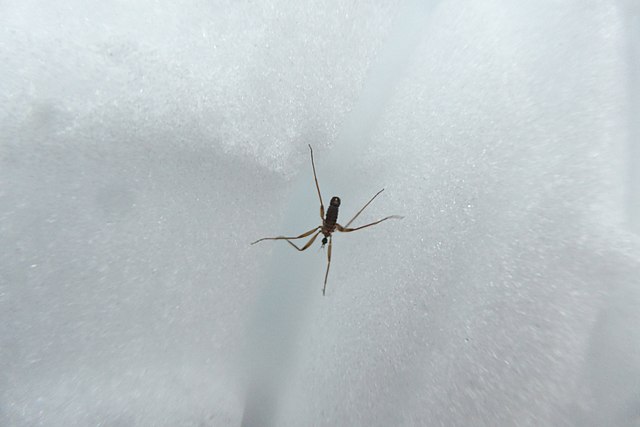Introduction
The snow fly (Chionea) is a wingless crane fly in the genus Limoniid. It is notable for being one of the few insects to remain active during the winter months. The insect’s idiosyncratic anatomy enables it to survive in sub-freezing temperatures. The snow fly was first described in Alberta, Canada. At least 40 species of snow fly have since been discovered across the Northern hemisphere. When they are present, snow flies can often be observed quickly navigating across the snow and ice in search of mates. Snow flies are not believed to feed on live plant material. As such, they are not considered plant nuisances.
Distribution & Habitat
The snow fly is widespread across the Northern hemisphere. Its range encompasses much of North America, Europe, and Asia. In the western part of its range, the snow fly tends to frequent mountain ranges. Eastern snow flies are most often found in densely forested regions. Snow flies are more prevalent when temperatures are below freezing.
Hosts
Snow flies do not seek out any particular hosts to feed in, or lay their eggs on.
Description
The eggs laid by the females are small and ovate. The larvae that hatch from the eggs are initially small, but grow larger as they feed. They have a soft, grub-like body, and a head that is shaped like a capsule. Their hardened mouthparts are their most prominent feature. The adults have three sets of long legs, and several plated abdominal segments, as well as a rounded head, bulbous eyes, and antennae that protrude outward. A proboscis extends from the front of the insect’s head, comprising its mouthparts. The proboscis is used primarily for drinking water. The male’s posterior curves upward, before terminating in a point.
Snow flies produce a chemical called glycerol in their haemolymph. The glycerol increases the viscosity of the snow fly’s bodily fluids. This trait enables the insect to survive in the frigid winter temperatures without freezing. However, it also seemingly inhibits them from functioning effectively in warmer climates. The adults are not believed to consume solid food. This prevents food particles from forming ice crystals within them.
Life Cycle
The snow fly passes through four stages during its life cycle: an egg stage, a larval stage, a pupal stage, and an adult stage. Snow flies reproduce from September to May. Their populations generally peak from October to November, with a second peak occurring from February to March. After the adults have emerged from their pupal chambers, they seek out partners to mate with. Snow flies are often spread out, which can make it difficult for them to find mates immediately. As such, the adults select partners indiscriminately. Once two snow flies have located each other, they proceed to mate. The mating process lasts for 30 to 70 minutes. Prior to copulating, the adults assume a mating position that differs from that of their winged counterparts. This is probably influenced by the snow fly’s unique anatomical construction.
After mating, the females deposit up to 200 individual eggs in leaf litter and rodent nests, as well as beneath decaying logs and stumps. The larvae hatch within 1 to 3 weeks. They commence feeding – likely on rodent feces and organic debris – until they have matured. Once mature, the larvae pupate. The adults appear soon thereafter, and the cycle begins anew.
Management
- Snow flies do not cause damage to plants. They do not require management.
- Rock crickets (Grylloblattidae) are the snow fly’s most common natural predator. When they are both present in an area, rock crickets help to significantly reduce snow fly populations.
- Snow flies are consumed by mice, rats, and winter birds.
- Snow fly eggs are eaten by numerous beetle grubs, caterpillars, and fleas.
- The larvae can be infested by a tapeworm species. The tapeworm is believed to come into contact with the larvae when they feed on mice feces.
- A species of nematode has been found to sometimes parasitize the larvae and adults.
Additional Resources:
https://bugguide.net/node/view/42999
https://www.emporia.edu/dotAsset/14b145a4-e866-4df8-8e6a-62b50716a599.pdf


